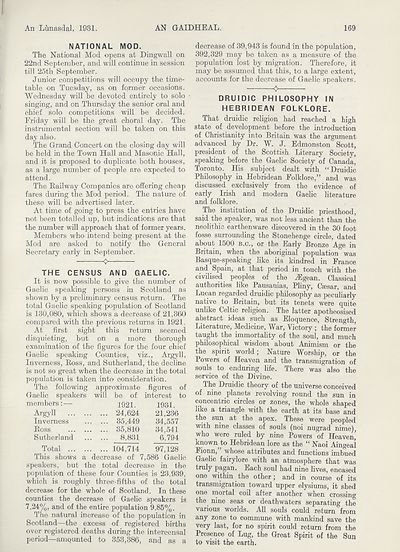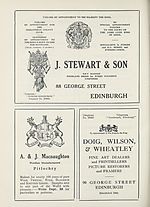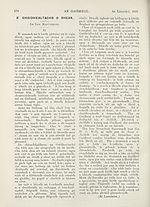An Comunn Gàidhealach Publications > Gaidheal > Volume 26, October 1930--September 1931
(221) Page 169
Download files
Complete book:
Individual page:
Thumbnail gallery: Grid view | List view

An Lunasdal, 1931.
AN GAIDHEAL.
169
NATIONAL MOD.
The National Mod opens at Dingwall on
22nd September, and will continue in session
till 25th September.
Junior competitions will occupy the time¬
table on Tuesday, as on former occasions.
Wednesday will be devoted entirely to solo
singing, and on Thursday the senior oral and
chief solo competitions will be decided.
Friday will be the great choral day. The
instrumental section will be taken on this
day also.
The Grand Concert on the closing day will
be held in the Town Hall and Masonic Hall,
and it is proposed to duplicate both houses,
as a large number of people are expected to
attend.
The Eailway Companies are offering cheap
fares during the Mod period. The nature of
these will be advertised later.
At time of going to press the entries have
not been totalled up, but indications are that
the number will approach that of former years.
Members who intend being present at the
Mod are asked to notify the General
Secretary early in September.
O
THE CENSUS AND GAELIC.
It is now possible to give the number of
Gaelic speaking persons in Scotland as
shown by a preliminary census return. The
total Gaelic speaking population of Scotland
is 130,080, which shows a decrease of 21,360
compared with the previous returns in 1921.
At first sight this return seemed
disquieting, but on a more thorough
examination of the figures for the four chief
Gaelic speaking Counties, viz., Argyll,
Inverness, Ross, and Sutherland, the decline
is not so great when the decrease in the total
population is taken into consideration.
The following approximate figures of
Gaelic speakers will be of interest to
members:— 1921. 1931.
Argyll 24,624 21,236
Inverness 35,449 34,557
Ross 35,810 34,541
Sutherland 8,831 6,794
Total 104,714 97,128
This shows a decrease of 7,586 Gaelic
speakers, but the total decrease in the
population of these four Counties is 23,939,
which is roughly three-fifths of the total
decrease for the whole of Scotland. In these
counties the decrease of Gaelic speakers is
7.24%, and of the entire population 9.85%.
The natural increase of the population in
Scotland—the excess of registered births
over registered deaths during the intercensal
period—amounted to 353,386, and as a
decrease of 39,943 is found in the population,
392,329 may be taken as a measure of the
population lost by migration. Therefore, it
may be assumed that this, to a large extent,
accounts for the decrease of Gaelic speakers.
0
DRUIDIC PHILOSOPHY IN
HEBRIDEAN FOLKLORE.
That druidic religion had reached a high
state of development before the introduction
of Christianity into Britain was the argument
advanced by Dr. W. J. Edmonston Scott,
president of the Scottish Literary Society,
speaking before the Gaelic Society of Canada!
Toronto. His subject dealt with “Druidic
Philosophy in Hebridean Folklore,” and was
discussed exclusively from the evidence of
early Irish and modern Gaelic literature
and folklore.
The institution of the Druidic priesthood,
said the speaker, was not less ancient than the
neolithic earthenware discovered in the 30 foot
fosse surrounding the Stonehenge circle, dated
about 1500 B.c., or the Early Bronze Age in
Britain, when the aboriginal population was
Basque-speaking like its kindred in France
and Spain, at that period in touch with the
civilised peoples of the ^Egean. Classical
authorities like Pausauias, Pliny, Ceesar, and
Lucan regarded druidic philosophy as peculiarly
native to Britain, but its tenets were quite
unlike Celtic religion. The latter apotheosised
abstract ideas such as Eloquence, Strength,
Literature, Medicine, War, Victory ; the former
taught the immortality of the soul, and much
philosophical wisdom about Animism or the
the spirit world; Nature Worship, or the
Powers of Heaven and the transmigration of
souls to enduring life. There was also the
service of the Divine.
The Druidic theory of the universe conceived
of nine planets revolving round the sun in
concentric circles or zones, the whole shaped
like a triangle with the earth at its base and
the sun at the apex. These were peopled
with nine classes of souls (noi nugrad nime),
who were ruled by nine Powers of Heaven,’
known to Hebridean lore as the “ Naoi Aingeal
Fionn,” whose attributes and functions imbued
Gaelic fairylore with an atmosphere that was
truly pagan. Each soul had nine lives, encased
one within the other ; and in course of its
transmigration toward upper elysiums, it shed
one mortal coil after another when crossing
the nine seas or death waters separating the
various worlds. All souls could return from
any zone to commune with mankind save the
very last, for no spirit could return from the
Presence of Lug, the Great Spirit of the Sun
to visit the earth.
AN GAIDHEAL.
169
NATIONAL MOD.
The National Mod opens at Dingwall on
22nd September, and will continue in session
till 25th September.
Junior competitions will occupy the time¬
table on Tuesday, as on former occasions.
Wednesday will be devoted entirely to solo
singing, and on Thursday the senior oral and
chief solo competitions will be decided.
Friday will be the great choral day. The
instrumental section will be taken on this
day also.
The Grand Concert on the closing day will
be held in the Town Hall and Masonic Hall,
and it is proposed to duplicate both houses,
as a large number of people are expected to
attend.
The Eailway Companies are offering cheap
fares during the Mod period. The nature of
these will be advertised later.
At time of going to press the entries have
not been totalled up, but indications are that
the number will approach that of former years.
Members who intend being present at the
Mod are asked to notify the General
Secretary early in September.
O
THE CENSUS AND GAELIC.
It is now possible to give the number of
Gaelic speaking persons in Scotland as
shown by a preliminary census return. The
total Gaelic speaking population of Scotland
is 130,080, which shows a decrease of 21,360
compared with the previous returns in 1921.
At first sight this return seemed
disquieting, but on a more thorough
examination of the figures for the four chief
Gaelic speaking Counties, viz., Argyll,
Inverness, Ross, and Sutherland, the decline
is not so great when the decrease in the total
population is taken into consideration.
The following approximate figures of
Gaelic speakers will be of interest to
members:— 1921. 1931.
Argyll 24,624 21,236
Inverness 35,449 34,557
Ross 35,810 34,541
Sutherland 8,831 6,794
Total 104,714 97,128
This shows a decrease of 7,586 Gaelic
speakers, but the total decrease in the
population of these four Counties is 23,939,
which is roughly three-fifths of the total
decrease for the whole of Scotland. In these
counties the decrease of Gaelic speakers is
7.24%, and of the entire population 9.85%.
The natural increase of the population in
Scotland—the excess of registered births
over registered deaths during the intercensal
period—amounted to 353,386, and as a
decrease of 39,943 is found in the population,
392,329 may be taken as a measure of the
population lost by migration. Therefore, it
may be assumed that this, to a large extent,
accounts for the decrease of Gaelic speakers.
0
DRUIDIC PHILOSOPHY IN
HEBRIDEAN FOLKLORE.
That druidic religion had reached a high
state of development before the introduction
of Christianity into Britain was the argument
advanced by Dr. W. J. Edmonston Scott,
president of the Scottish Literary Society,
speaking before the Gaelic Society of Canada!
Toronto. His subject dealt with “Druidic
Philosophy in Hebridean Folklore,” and was
discussed exclusively from the evidence of
early Irish and modern Gaelic literature
and folklore.
The institution of the Druidic priesthood,
said the speaker, was not less ancient than the
neolithic earthenware discovered in the 30 foot
fosse surrounding the Stonehenge circle, dated
about 1500 B.c., or the Early Bronze Age in
Britain, when the aboriginal population was
Basque-speaking like its kindred in France
and Spain, at that period in touch with the
civilised peoples of the ^Egean. Classical
authorities like Pausauias, Pliny, Ceesar, and
Lucan regarded druidic philosophy as peculiarly
native to Britain, but its tenets were quite
unlike Celtic religion. The latter apotheosised
abstract ideas such as Eloquence, Strength,
Literature, Medicine, War, Victory ; the former
taught the immortality of the soul, and much
philosophical wisdom about Animism or the
the spirit world; Nature Worship, or the
Powers of Heaven and the transmigration of
souls to enduring life. There was also the
service of the Divine.
The Druidic theory of the universe conceived
of nine planets revolving round the sun in
concentric circles or zones, the whole shaped
like a triangle with the earth at its base and
the sun at the apex. These were peopled
with nine classes of souls (noi nugrad nime),
who were ruled by nine Powers of Heaven,’
known to Hebridean lore as the “ Naoi Aingeal
Fionn,” whose attributes and functions imbued
Gaelic fairylore with an atmosphere that was
truly pagan. Each soul had nine lives, encased
one within the other ; and in course of its
transmigration toward upper elysiums, it shed
one mortal coil after another when crossing
the nine seas or death waters separating the
various worlds. All souls could return from
any zone to commune with mankind save the
very last, for no spirit could return from the
Presence of Lug, the Great Spirit of the Sun
to visit the earth.
Set display mode to:
![]() Universal Viewer |
Universal Viewer | ![]() Mirador |
Large image | Transcription
Mirador |
Large image | Transcription
| An Comunn Gàidhealach > An Comunn Gàidhealach Publications > Gaidheal > Volume 26, October 1930--September 1931 > (221) Page 169 |
|---|
| Permanent URL | https://digital.nls.uk/125155056 |
|---|
| Description | This contains items published by An Comunn, which are not specifically Mòd-related. It includes journals, annual reports and corporate documents, policy statements, educational resources and published plays and literature. It is arranged alphabetically by title. |
|---|
| Description | A collection of over 400 items published by An Comunn Gàidhealach, the organisation which promotes Gaelic language and culture and organises the Royal National Mòd. Dating from 1891 up to the present day, the collection includes journals and newspapers, annual reports, educational materials, national Mòd programmes, published Mòd literature and music. |
|---|---|
| Additional NLS resources: |
|

